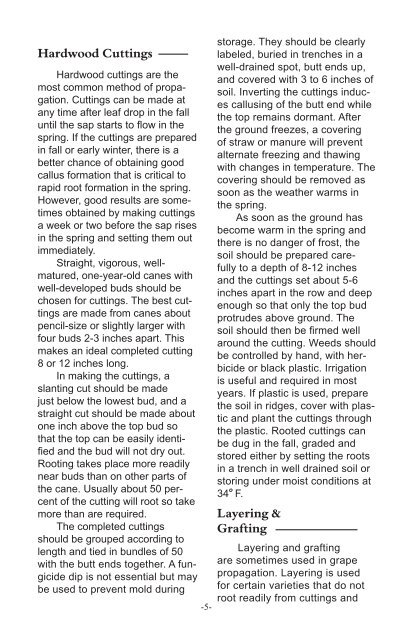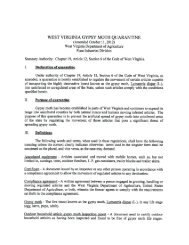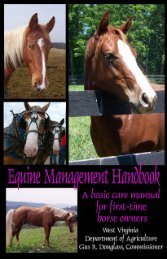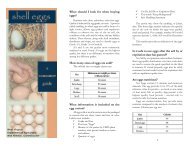Growing Grapes in WV - West Virginia Department of Agriculture
Growing Grapes in WV - West Virginia Department of Agriculture
Growing Grapes in WV - West Virginia Department of Agriculture
Create successful ePaper yourself
Turn your PDF publications into a flip-book with our unique Google optimized e-Paper software.
Hardwood Cutt<strong>in</strong>gsHardwood cutt<strong>in</strong>gs are themost common method <strong>of</strong> propagation.Cutt<strong>in</strong>gs can be made atany time after leaf drop <strong>in</strong> the falluntil the sap starts to flow <strong>in</strong> thespr<strong>in</strong>g. If the cutt<strong>in</strong>gs are prepared<strong>in</strong> fall or early w<strong>in</strong>ter, there is abetter chance <strong>of</strong> obta<strong>in</strong><strong>in</strong>g goodcallus formation that is critical torapid root formation <strong>in</strong> the spr<strong>in</strong>g.However, good results are sometimesobta<strong>in</strong>ed by mak<strong>in</strong>g cutt<strong>in</strong>gsa week or two before the sap rises<strong>in</strong> the spr<strong>in</strong>g and sett<strong>in</strong>g them outimmediately.Straight, vigorous, wellmatured,one-year-old canes withwell-developed buds should bechosen for cutt<strong>in</strong>gs. The best cutt<strong>in</strong>gsare made from canes aboutpencil-size or slightly larger withfour buds 2-3 <strong>in</strong>ches apart. Thismakes an ideal completed cutt<strong>in</strong>g8 or 12 <strong>in</strong>ches long.In mak<strong>in</strong>g the cutt<strong>in</strong>gs, aslant<strong>in</strong>g cut should be madejust below the lowest bud, and astraight cut should be made aboutone <strong>in</strong>ch above the top bud sothat the top can be easily identifiedand the bud will not dry out.Root<strong>in</strong>g takes place more readilynear buds than on other parts <strong>of</strong>the cane. Usually about 50 percent<strong>of</strong> the cutt<strong>in</strong>g will root so takemore than are required.The completed cutt<strong>in</strong>gsshould be grouped accord<strong>in</strong>g tolength and tied <strong>in</strong> bundles <strong>of</strong> 50with the butt ends together. A fungicidedip is not essential but maybe used to prevent mold dur<strong>in</strong>g-5-storage. They should be clearlylabeled, buried <strong>in</strong> trenches <strong>in</strong> awell-dra<strong>in</strong>ed spot, butt ends up,and covered with 3 to 6 <strong>in</strong>ches <strong>of</strong>soil. Invert<strong>in</strong>g the cutt<strong>in</strong>gs <strong>in</strong>ducescallus<strong>in</strong>g <strong>of</strong> the butt end whilethe top rema<strong>in</strong>s dormant. Afterthe ground freezes, a cover<strong>in</strong>g<strong>of</strong> straw or manure will preventalternate freez<strong>in</strong>g and thaw<strong>in</strong>gwith changes <strong>in</strong> temperature. Thecover<strong>in</strong>g should be removed assoon as the weather warms <strong>in</strong>the spr<strong>in</strong>g.As soon as the ground hasbecome warm <strong>in</strong> the spr<strong>in</strong>g andthere is no danger <strong>of</strong> frost, thesoil should be prepared carefullyto a depth <strong>of</strong> 8-12 <strong>in</strong>chesand the cutt<strong>in</strong>gs set about 5-6<strong>in</strong>ches apart <strong>in</strong> the row and deepenough so that only the top budprotrudes above ground. Thesoil should then be firmed wellaround the cutt<strong>in</strong>g. Weeds shouldbe controlled by hand, with herbicideor black plastic. Irrigationis useful and required <strong>in</strong> mostyears. If plastic is used, preparethe soil <strong>in</strong> ridges, cover with plasticand plant the cutt<strong>in</strong>gs throughthe plastic. Rooted cutt<strong>in</strong>gs canbe dug <strong>in</strong> the fall, graded andstored either by sett<strong>in</strong>g the roots<strong>in</strong> a trench <strong>in</strong> well dra<strong>in</strong>ed soil orstor<strong>in</strong>g under moist conditions ato34 F.Layer<strong>in</strong>g &Graft<strong>in</strong>gLayer<strong>in</strong>g and graft<strong>in</strong>gare sometimes used <strong>in</strong> grapepropagation. Layer<strong>in</strong>g is usedfor certa<strong>in</strong> varieties that do notroot readily from cutt<strong>in</strong>gs and

















